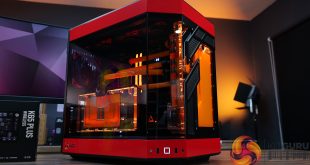For power supply units specifications are rather straightforward; the manufacturer specifies how much power under specific circumstances their product can output. For example, a 500W power supply can (supposedly) continuously output up to 500W worth of DC power. However output power and input power differ significantly.
Input power relies on the unit's efficiency and efficiency is not constant across its entire load range. It is not wise to try and calculate the input power based on the manufacturer's ratings; if the power supply is 80Plus certified you should take into account the 80Plus program specification limits at 100% load, otherwise you should consider the efficiency to be as low as 60%. Let us speculate that our 500W power supply carries an 80Plus Bronze certification which implies an efficiency of at least 81% at maximum load. At maximum load our power supply will output 500W worth of DC power but will consume
![]()
So now we have the Watts rating of our power supply. But UPS units are also rated in VA. Most computer PSUs nowadays feature active power factor correction (APFC) which allows them to have a power factor of up to 99%, however if a manufacturer states that their unit features APFC but not a specific rating you should consider it to be as low as 90%. Passive PFC power supplies have a power factor of 70-75% and units without any form of power factor correction (which are nearly extinct) have a power factor as low as 50%. We will assume that our 500W 80Plus Bronze certified power supply has an APFC rating of 0.97.
Most UPS products from reputable manufacturers have both a VAs and a Watts rating. Neither of the two ratings may be exceeded, which is the most common cause of sizing errors. For example, an APC RS 1200VA/720W UPS can output either 1200VA or 720W of power and will cease to operate if either rating is exceeded. Here are the examples of three hypothetical loads:
As you can see, it is very easy for a low quality 400W switching PSU to overload a rather powerful UPS. At the same time, the same UPS can power a significantly more powerful high quality PSU.
But what about other computer loads such as monitors, printers and speakers? Manufacturers always display the AC Watt specifications of their monitors and all TFT monitors can be safely assumed to have a power factor of over 95%; therefore it is easy to calculate the exact VAs consumption or even safely assume that the VAs and Watts are almost equal. Laser printers and powerful speakers should not be connected to the battery backup outlets of the UPS because they draw immense amounts of power but the surge protection outlets can be used. Low power speakers and most inkjet printers can be safely connected to battery backup outlets because their power consumption is very low and their power factors are high, however you might want to avoid connecting non-essential devices to the battery backup because the battery runtime decreases exponentially as the UPS load increases.
If you wish to discuss this article, please head into our forums and debate with IronLaw or just leave a quick comment below.
 KitGuru KitGuru.net – Tech News | Hardware News | Hardware Reviews | IOS | Mobile | Gaming | Graphics Cards
KitGuru KitGuru.net – Tech News | Hardware News | Hardware Reviews | IOS | Mobile | Gaming | Graphics Cards



